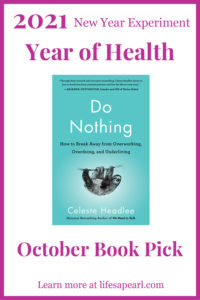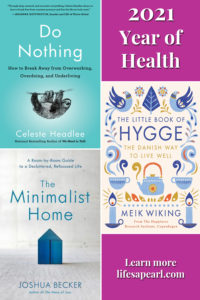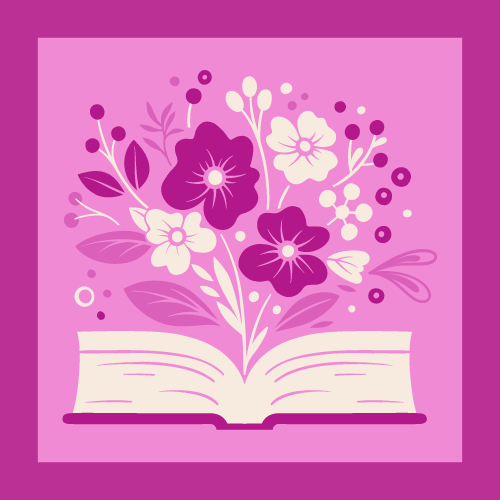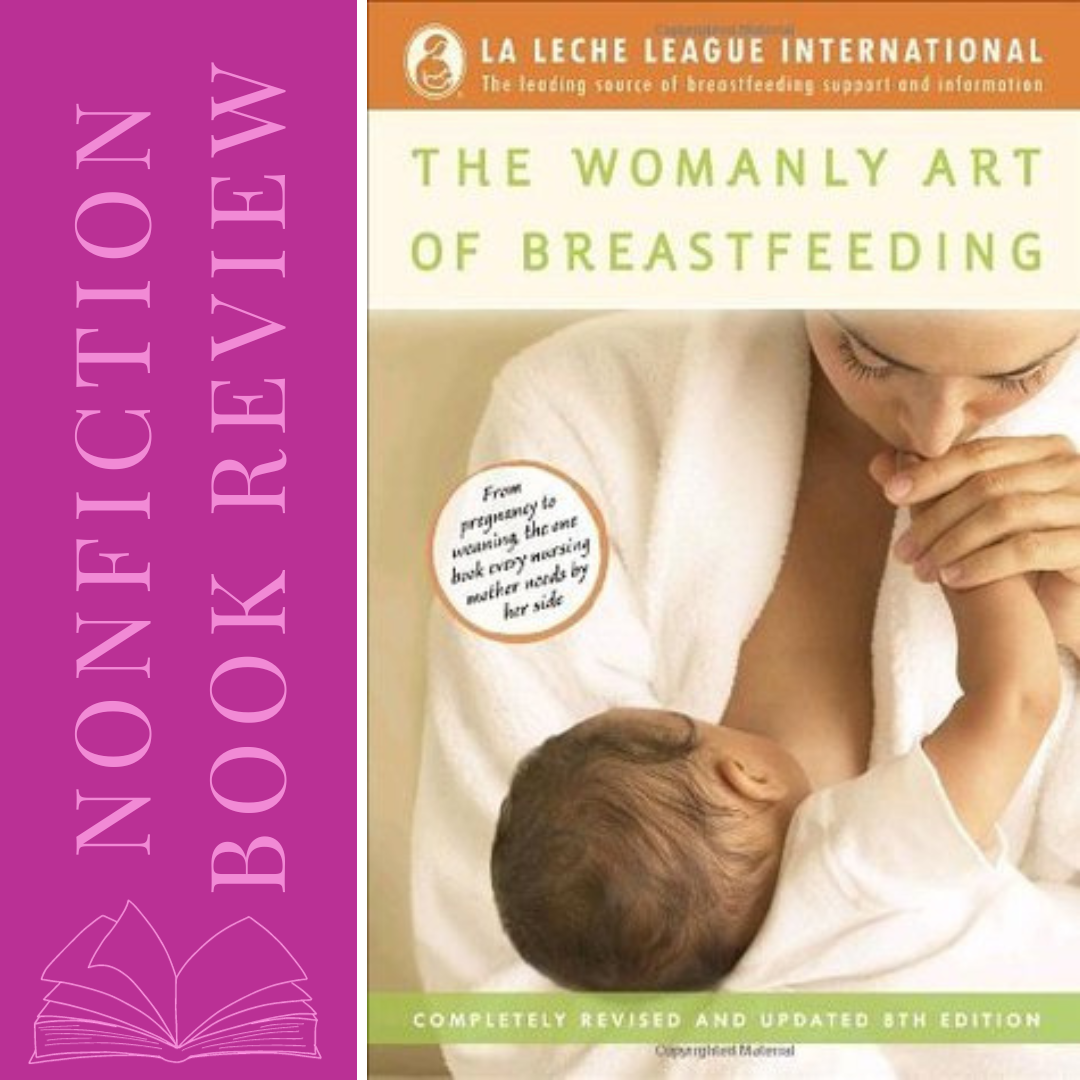For 2021, I decided to take on a year of health project rather than making New Years resolutions. While I have the best of intentions at the start of every year, my resolutions never seem to last for long.
The idea behind this experiment is to explore a new health topic for each month of the year. These topics could include anything from nutrition to stress management to exercise to social connections.
Each month I choose a nonfiction book to read in the first half. Then I try to implement what I’ve learned in the second half of the month.
So far this year I’ve read about cutting out sugar, relationships, and how nutrition affects our genes. In the second quarter, I learned about sleep, multipotentialites, and the connection between nature and health. The third quarter covered going Beyond Labels by taking responsibility for your food sources and the importance of physical movement.
A Pregnancy Update
This pregnancy though has thrown us for so many loops – probably the best preparation for parenthood!
The latest one had us going the cesarean route for delivery due to the baby being transverse. We had the date set, the surgery scheduled, and worked through all our feelings about the change in direction. It was not our ideal experience but I was grateful for the safe delivery option and the time to prepare for a planned cesarean.
Almost every pregnancy book I had previously read only covered how to avoid c-sections usually accompanied with a list of negative effects for baby, mom, and early bonding. Not a very realistic or supportive stance when at least 1 in 4 babies are delivered this way. With us going that route, I switched September’s topic to breastfeeding rather than natural childbirth.
Then at our final pre-op appointment (almost 39 weeks!) he had flipped head down. Just days before surgery! I guess at least it wasn’t the morning of. Apparently this happens with about 1 in 20 breech babies after 38 weeks so it’s not impossible but definitely not common.
Now we are back to waiting for him to decide when to come and I’m rapidly refreshing my knowledge and preparation for a vaginal birth.
That’s the latest update on our pregnancy journey. It’s been a bit of a roller coaster. As I’m sure many people’s experiences are. Though I’m building hope again for a low intervention birth, we could still wind up with a c-section for many reasons so it’s probably good I had the chance to read more about that delivery possibility beforehand.
September Topic: Breastfeeding
September’s book pick wound up being The Womanly Art of Breastfeeding. It’s a book I planned to read anyway before my due date. Nursing is something I had zero knowledge of and it’s personally important to me.
That being said everyone has a different journey, different circumstances, and different views. None of which is better than another. A fed baby is best, whether that’s via formula or breastfeeding.
This book is quick to tote all the amazing benefits of breastfeeding. Some of which I’ve read in the awesomely unbiased data book, Cribsheet by Emily Oster, are drawn from bad research and tend to be blown out of proportion. My takeaways will focus more on the mechanical information, troubleshooting, and support sections of this book.
Review: The Womanly Art of Breastfeeding by Diane Wiessinger, Diana West, and Teresa Pitman
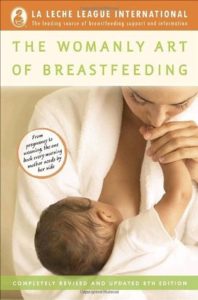
The Womanly Art of Breastfeeding is a guidebook put together by La Leche League International. Originally published in 1958, this latest edition was revised by La Leche Members – Diane Wiessinger, Diana West, and Teresa Pitman – in 2010.
This book seeks to educate, empower, and support mothers by offering in depth information, personal anecdotes, troubleshooting advice, and pathways to further resources. At over 500 pages, it covers all stages of nursing, common questions, and frequent problems or struggles that may come up.
Starting with a new beginnings section, the authors cover the benefits of breastfeeding, how to set up a support system, how different modes of births may affect breastfeeding, and basic latching and position information. Part two goes into depth on the various stages of breastfeeding from the first few days of a baby’s life to nursing toddlers and beyond. The third part is all about questions, troubleshooting, and tech support. Part four outlines quick resources and how to get further help.
Some Interesting Takeaways:
- In the first two to three weeks of breastfeeding, your milk supply is being calibrated. The more milk that is removed during this time, the more milk you will produce. Each breast is measured independently.
- Newborn babies have tiny stomachs. It’s normal for them to nurse a little bit, doze, and then wake to start all over. Newborns become well fed and a good milk supply is established through frequent feedings.
- In the first few days, colostrum is produced rather than milk. If your baby isn’t nursing, you can express colostrum to give them. The most colostrum can usually be expressed in the first hours post birth.
- Skin to skin contact is very important and the best method to warm a baby. Your breasts can actually change temperature to help regulate your baby.
- After a c-section, the easiest positions for breastfeeding are usually lying flat your back with the baby on your chest or sitting upright with pillows behind your back and on your lap to protect the incision.
- Once home, you can know your baby is doing well by looking for at least 3 poopy diapers that are the size of the “ok” sign. Other ways to tell are if nursing is comfortable and your baby’s disposition.
- Use fists as a guide to hunger – clenched fists mean hungry. Feeding when you notice hunger cues helps keep things low stress. It’s better to offer often than follow a schedule.
- All world and western health organizations agree that babies don’t need solids before six months – under normal circumstances.
- Breastfed babies slow down their weight gain around 4 months and again between 7 and 9 months. Only the World Health Organization weight gain charts reflect this. It’s important to know which chart your doctor is using if they become concerned.
Quotes from The Womanly Art of Breastfeeding:
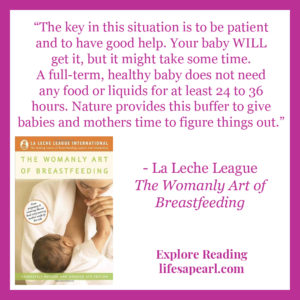

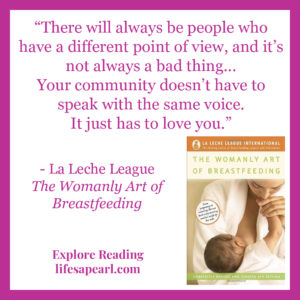
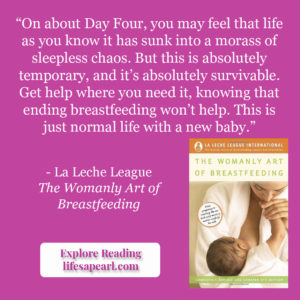
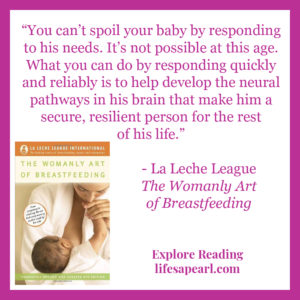
Final Verdict on The Womanly Art of Breastfeeding:
I found this book incredibly informative. It offered answers to questions and concerns I had not even thought of or known were possibilities since I haven’t experienced breastfeeding myself yet. But it did so in a reassuring and comforting tone.
The overall attitude is that if breastfeeding is something important to you, there’s an answer to making it work. Support, education, and commitment are key. I found that comforting and hopefully it rings true.
I thought the authors’ approach was pretty down to earth and nonjudgemental. Some reviews criticized the chapters about pumping and going back to work. Maybe not every idea would work for every mother or job situation but I felt they offered realistic tips and advice for continuing a breastfeeding relationship.
My favorite parts as shown by the quotes that stuck out to me were the encouragment for a low pressure and low stress approach to breastfeeding, the emphasis on it being a learned skill for both mom and baby, and the reassurance that it’s ok to be feeling any and all sorts of emotions during early motherhood.
Many sections also featured a resource list with book recommendations and online sources for further information from sleep to weaning to early child development. I always love a great book list!
Final Quarter of 2021 Reading List
- Do Nothing: How to Break Away from Overworking, Overdoing, and Underliving by Celeste Headlee
- The Minimalist Home: A Room-By-Room Guide to a Decluttered, Refocused Life by Joshus Becker
- The Little Book of Hygge: The Danish Way to Live Well by Meik Wiking
Book Pick for October

October’s Year of Health book pick is Do Nothing: How to Break Away from Overworking, Overdoing, and Underliving by Celeste Headlee.
I didn’t know a ton about this book when I selected it. But realizing that in October I’d be adjusting as a new mom, the title really appealed to me. I have a hard time letting myself be still or relaxed without guilt. I feel like I should always be doing something whether it’s tackling the next goal to checking off the next item on my to do list to tiny things like just tidying up. There will always be something else to do. So it would be nice to feel ok about taking a break. Especially with a new baby to enjoy.
Research shows that even as our culture searches for ways to hack health and happiness, humans are working more rather than less and dealing with more cases of depression and anxiety. Do Nothing shares a new path forward with a global shift in mindset to embracing the things that make us human and the areas where we find meaning. We can learn to measure time in terms of meaning rather than efficiency. The idea is to stop sabotaging our own health, to be able to set aside work, and to really begin living.
Please share your new mom experiences below. Have you read The Womanly Art of Breastfeeding? If you breastfed, what resources did you find helpful and how were you supported?
